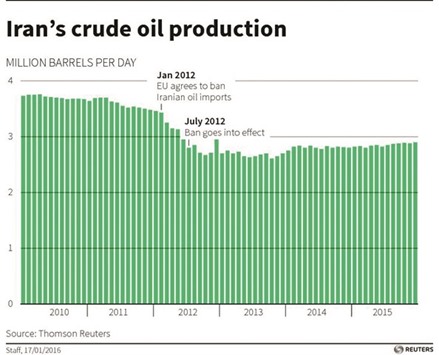The first coordinated decision on oil output between Opec and producers outside the group in fifteen years isn’t going to revive crude prices, according to Goldman Sachs Group Inc.
The agreement between Saudi Arabia and Russia to freeze production will have “little impact on the oil market as proposed, while there remains high uncertainty that it even materialises,” analysts including Jeffrey Currie said in a note e-mailed yesterday. The bank reiterated its call for prices to remain volatile while being bound to a range in the coming months until inventories stop increasing.
Oil is trading near a 12-year low as record stockpiles continue to swell more than a year after the Organization of Petroleum Exporting Countries decided to keep pumping to defend market share amid a global glut. Coupled with record Russian output and US shale fields producing more oil and gas than previously estimated, prices could slide below $20 a barrel before the rout is over, Currie said last week.
“While an agreement could create the perception that more could be achieved, such as production cuts, we believe this would not be sufficient to set a floor on prices as they will only stabilise once inventories stop building,” according to Goldman, which predicts that stockpiles may stop increasing in the second half of this year. Additionally, a broader reduction in output would be self-defeating as shale producers could boost output in 80 days when prices start to recover, Currie said in a separate Bloomberg Television interview on Tuesday.
Brent for April settlement was little changed at $32.19 a barrel on the London-based ICE Futures Europe exchange at 2.34pm Singapore time. West Texas Intermediate for March delivery traded at $28.95 a barrel on the New York Mercantile Exchange.
Oversea-Chinese Banking Corp thinks a production cut will occur “sooner or later,” economist Barnabas Gan said in a report yesterday. Opec may call for an emergency meeting as early as March as the slump in oil prices squeezes profit margins, he said.
“We think that a production cut in the major oil producers will happen in 2016,” said Gan. “This event, coupled with demand growth to stay positive, would rally both WTI and Brent to our year-end forecast of $50 a barrel.”
While Saudi Arabia and Russia, the world’s biggest crude oil producers, joined Venezuela and Qatar in an agreement on Tuesday to cap output, the success of the deal will depend on Iran, Iraq and other large exporters taking part, with the participation of Iran “unlikely,” according to Goldman.
Iran, which was Opec’s second-biggest producer before sanctions were stepped up in 2012, “will not forgo its share of the market,” the Oil Ministry’s news service Shana reported on Tuesday, citing Zanganeh. An Iraqi official said his country was prepared to back the plan.
“Iran has continued to comment that it is committed to growing production and regaining market share, suggesting that any deal involving Iran would likely need to allow for some production growth,” said Currie. “We remain conservative on our Iranian production growth forecast given the only limited increase in exports achieved so far and the limitation that the remaining US sanctions create in ramping up output.”

..
